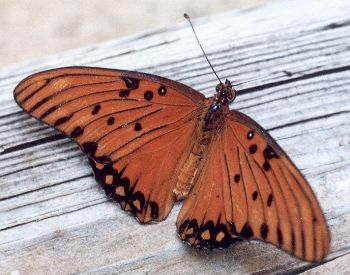Heliconids
by Valerie (June 2, 2000)
revised August 24, 2003
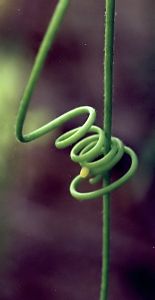
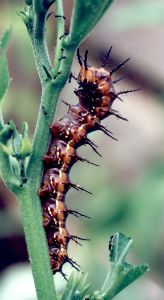 Because we grow passionflower vines, we have a large number of butterflies of the Heliconidae family. The main species that visits our gardens is the Gulf fritillary (Agraulis vanillae incarnata), which is not a fritillary at all but related to the butterflies of the genus Heliconius: a huge group of neotropical species famous for being mimicked by other genera. The heliconids are supposedly unpalatable to birds because their main food source as larvae is the passionflower, which gives them a nasty taste. The wings of the Gulf fritillary are orange with small black spots on top and brown with large white spots underneath. Because we grow passionflower vines, we have a large number of butterflies of the Heliconidae family. The main species that visits our gardens is the Gulf fritillary (Agraulis vanillae incarnata), which is not a fritillary at all but related to the butterflies of the genus Heliconius: a huge group of neotropical species famous for being mimicked by other genera. The heliconids are supposedly unpalatable to birds because their main food source as larvae is the passionflower, which gives them a nasty taste. The wings of the Gulf fritillary are orange with small black spots on top and brown with large white spots underneath.
The caterpillars appear, sometimes in large numbers, as soon as the vines start to grow in the spring. Only the fact that passionflowers are extremely fast-growing saves them from being completely defoliated by the insects. The butterflies seek out areas of the plant that have no other eggs laid on them (the eggs are bright yellow and look like small pimples) and deposit single eggs, often on one of the tendrils. The reason they do this is because the young larvae are cannibalistic. Some species of passionflower actually have a pair of tiny yellow bumps at the base of each leaf which resemble the eggs, possibly to discourage butterflies from laying on that particular leaf since they perceive it to be already occupied.
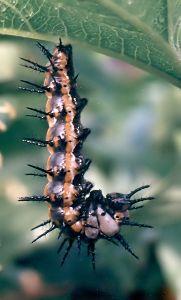
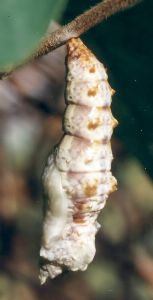 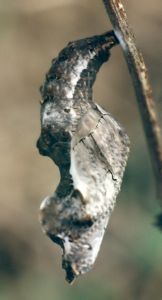
Although I've never witnessed any attacks, I suspect the heliconids are not immune from the most voracious predator of caterpillars we have: wasps. When there are few caterpillars, there are often many foraging wasps hunting amidst the leaves. Birds probably don't bother them because of their bad taste and the prickly-looking spines on their bodies. 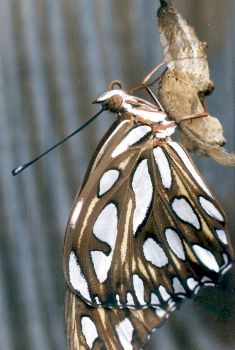
When the caterpillars are ready to pupate, they attach themselves upsidedown to a stem or other support (sometimes there are several hanging from the eaves of our house) and they begin their metamorphosis. After shedding a thin layer of their exoskeleton, their body begins to change drastically. It looks like it swells up and turns all blistery, then smooths out and hardens into the chrysalis. The chrysalis can move slightly at the abdomen end and shifts back and forth to stay out of the hot sun or avoid a touch.
Last summer we had a new visitor to our yard: a zebra butterfly (Heliconius charitonius). This is a tropical heliconid and it spent quite a bit of time hovering around the passionflower vines. Zebra butterflies have the slowest flight of any butterfly I've seen; they look like they're just drifting along with no effort at all.  |
